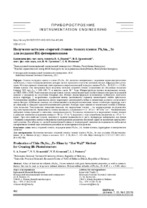| dc.contributor.author | Иванов, В. А. | |
| dc.contributor.author | Красовский, В. В. | |
| dc.contributor.author | Гременок, В. Ф. | |
| dc.contributor.author | Постнова, Л. И. | |
| dc.coverage.spatial | Минск | ru |
| dc.date.accessioned | 2021-12-02T13:04:40Z | |
| dc.date.available | 2021-12-02T13:04:40Z | |
| dc.date.issued | 2021 | |
| dc.identifier.citation | Получение методом «горячей стенки» тонких пленок PbxSn1–xTe для создания ИК-фотоприемников = Production of Thin PbxSn1–xTe Films by “Hot Wall” Method for Creating IR-Photodetectors / В. А. Иванов [и др.] // Наука и техника. – 2021. – № 6. – С. 482-486. | ru |
| dc.identifier.uri | https://rep.bntu.by/handle/data/107579 | |
| dc.description.abstract | Сплавы теллурида свинца и олова (PbxSn1–xTe) являются материалами с хорошими термоэлектрическими свойствами, а также полупроводниками, которые можно применять в качестве длинноволновых инфракрасных детекторов. Методом прямого плавления синтезирован поликристаллический теллурид сплавов PbxSn1–xTe (0,05 x 0,80). Тонкие пленки этих материалов были получены методом «горячей стенки» осаждением на стеклянные подложки Corning 7059 при Tsub = (200–350) oC и вакууме около 10–5 Торр. Микроструктура пленок исследовалась методами XRD, SEM и EDX. Рентгеновские спектры тонких пленок удовлетворительно соответствовали спектрам порошковой мишени и указывали на отсутствие бинарных фаз. Пленки демонстрировали естественную кубическую кристаллическую структуру. С возрастанием содержания свинца увеличивается параметр элементарной ячейки кристаллов. Установленная линейная зависимость между параметром элементарной ячейки и элементным составом соответствует закону Вегарда. SEM-анализ показал, что пленки являются поликристаллическими, имеют столбчатую структуру, плотно упакованы и обладают хорошей механической адгезией. Размеры зерен зависят от химического состава и температуры подложки. Электрические измерения показали, что выращенные пленки – это невырожденные полупроводники р-типа проводимости. Проводимость пленок находилась в диапазоне = (3 101)–(1 104) Ом–1см–1. Увеличение концентрации свинца приводит к снижению электропроводности. Холловская подвижность в выращенных тонких пленках в диапазоне изменения содержания свинца от 10 до 23 ат. % возрастает, а при дальнейшем увеличении до 33 ат. % – падает. При этом наиболее сильная зависимость падения подвижности от роста температуры наблюдается для пленок с большим содержанием свинца и объясняется преобладающим рассеянием носителей заряда на колебаниях кристаллической решетки. Для образца со средней концентрацией свинца в температурной зависимости подвижности наблюдается альтернативное влияние двух механизмов рассеяния: на ионах примеси и на фононах. | ru |
| dc.language.iso | ru | ru |
| dc.publisher | БНТУ | ru |
| dc.title | Получение методом «горячей стенки» тонких пленок PbxSn1–xTe для создания ИК-фотоприемников | ru |
| dc.title.alternative | Production of Thin PbxSn1–xTe Films by “Hot Wall” Method for Creating IR-Photodetectors | ru |
| dc.type | Article | ru |
| dc.identifier.doi | 10.21122/2227-1031-2021-20-6-482-486 | |
| local.description.annotation | Alloys of lead and tin telluride (PbxSn1–xTe) are materials with good thermoelectric properties, as well as semiconductors
that can be used as long-wave infrared detectors. Polycrystalline telluride of PbxSn1–xTe (0.05 x 0.80) alloys has been synthesized by direct fusion technique. Thin films of these materials have been obtained by the hot wall method depositing Сorning 7059 on glass substrates at Tsub = (200–350) oC and vacuum of about 10–5 Torr. The microstructure of the films has been investigated by XRD, SEM and EDX methods. The X-ray spectra of thin films have been in satisfactorily agreement with the spectra of the powder target and indicated the absence of binary phases. The films have shown a natural cubic crystalline structure. While increasing the lead content, the unit cell parameter of the crystal also increases. The established linear relationship between the unit cell parameter and the elemental composition corresponds to Vegard's law. The SEM analysis has shown that the films are polycrystalline, have a columnar structure, are tightly packed and have good mechanical adhesion. The grain size depends on the chemical composition and temperature of the substrate. The electrical measurements have shown that the grown films are non-degenerate semiconductors of p-type conductivity. The conductivity of the films was in the range of = (3 101)–(1 104) Ω–1cm–1. An increase of lead concentration leads to a decrease in electrical conductivity. Hall mobility in the grown thin films increases in the range of changes in the lead content from 10 to 23 at. %, and decreases with a further increase to 33 at. %. At the same time, the strongest dependence of the decrease in mobility on an increase in temperature increase is observed for films with a high lead content and is explained by the predominant scattering of charge carriers by vibrations of the crystal lattice. For a sample with an average lead concentration, an alternative effect of two scattering mechanisms is observed in the temperature dependence of the mobility: by impurity ions and by phonons. | ru |

